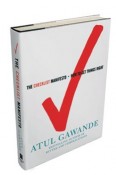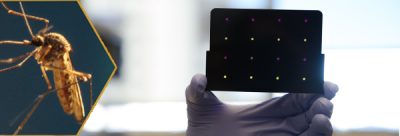ROBERT REICH-Once the pandemic is over and Trump is defeated, the system will still be broken.Who rigged it and how do we fix it?
Written on March 26th, 2020Before the pandemic, before Trump, millions of Americans had already lost confidence in our political and economic system. Stagnant wages, volatile job markets, an unwillingness to deal with threats like climate change, fed a sense that the system is fixed, and serves only those with enough money to buy power. ROBERT REICH and I talk about the pandemic and about his new book, THE SYSTEM: Who Rigged It and How Do We Fix It?
Disruptive #7: FISSEQ – Fluorescent In Situ Sequencing
Written on October 7th, 2016Until recently, to analyze many mRNAs simultaneously, scientists had to grind cells to a pulp, which left them unable to pinpoint those mRNAs within the cell. Developed by a team at the Wyss and Harvard Medical School, FISSEQ allows scientists to pinpoint thousands of mRNAs and other types of RNAs at once in intact cells, and stands to revolutionize clinical diagnostics and drug discovery.
Listen and subscribe to Disruptive on Soundcloud, iTunes, or Google Play.
Disruptive Episode #7 – FISSEQ – Fluorescent In Situ Sequencing
Written on October 5th, 2016DISRUPTIVE #7: FISSEQ – Fluorescent In Situ RNA Sequencing
Hello, I’m Terrence McNally and you’re listening to DISRUPTIVE the podcast from Harvard’s Wyss Institute for Biologically Inspired Engineering.
One of today’s guests, George Church, has made the point that as medicine moves from very blunt instruments – where you had to open up a chest all the way, for example, or had to use molecules that would hit almost every part of your body – now molecules can find one base pair out of six billion and change it – He says we need observational tools that can deal with that high level of resolution and comprehensiveness.
And we’re going to talk about one such tool. Fluorescent in situ RNA sequencing – F-I-S-S-E-Q – or FISSEQ.
Working copies of active genes — called messenger RNAs or mRNAs — are strategically positioned throughout living tissues, and their location often helps regulate how cells and tissues grow and develop. Until recently, to analyze many mRNAs simultaneously, scientists had to grind cells to a pulp, which left them unable to pinpoint where those mRNAs actually sat within the cell.
Now a team at the Wyss Institute and Harvard Medical School has developed a new method that allows scientists to pinpoint thousands of mRNAs and other types of RNAs at once – in intact cells.
FISSEQ could lead to earlier cancer diagnosis, help biologists better understand embryonic development, and even help map the neurons of the brain.
I’ll talk with George Church, Wyss Core Faculty member and co-founder of ReadCoor, the startup that will bring FISSEQ to market; Wyss lead senior scientist, Rich Terry, President, Co-Founder, and CTO of ReadCoor; and Shawn Marcell, Wyss Entrepreneur-in-Residence and founding Chairman/CEO of ReadCoor.
The mission of the Wyss Institute is to: Transform healthcare, industry, and the environment by emulating the way nature builds.
Our bodies — and all living systems — accomplish tasks far more sophisticated and dynamic than any entity yet designed by humans.
By emulating nature’s principles for self-organizing and self-regulating, Wyss researchers develop innovative engineering solutions for healthcare, energy, architecture, robotics, and manufacturing. [02:06]
George Church is Professor of Genetics at Harvard Medical School and Professor of Health Sciences and Technology at Harvard and MIT. He’s Director of the U.S. Department of Energy Center on Bioenergy at Harvard and MIT and director of the NIH Center for Excellence in Genomic Science at Harvard. He has co-founded a number of companies, including ReadCoor.
Church earned a bachelor’s degree from Duke University in two years and a PhD from Harvard. Honors include election to the National Academy of Sciences and the National Academy of Engineering. He has coauthored hundreds of scientific papers, more than sixty patents, and the book, “Regenesis: How Synthetic Biology Will Reinvent Nature and Ourselves.” [02:41]
To set the context for this episode, George Church offers an overview of the evolution of sequencing technology –
Church: It dates back at least to the ’60s when RNA sequencing and protein sequencing were the main ways of getting insight. In the mid-’70s, ways to do DNA sequencing based on electrophoresis came into play. Those were automated and made less radioactive, more fluorescent. In the ’80s and ’90s, it switched from slab electrophoresis, capillary electrophoresis. None of these scaled particularly well.
Continue reading “Disruptive Episode #7 — FISSEQ — Fluorescent In Situ Sequencing”
Disruptive#6: Rapid, Low-cost, Paper-based Test for Zika
Written on June 24th, 2016McNally:
Hello, I’m Terrence McNally and you’re listening to Disruptive, the podcast from Harvard’s Wyss Institute for biologically inspired engineering. In early May, a low cost, rapid, paper-based diagnostic system for strain specific detection of the Zika virus was introduced by an international consortium of researchers led by synthetic biologist James Collins with the goal that it could soon be used in the field to screen blood, urine or saliva samples.
The core of the test kit is a piece of paper that changes color in the presence of Zika virus RNA and produces results in two to three hours. Much faster and cheaper than the PCR test used now according to Collins, a Wyss core faculty member – and it should cost less than a dollar per test adds University of Toronto biochemist Keith Pardee.
I’m going to speak with both of them about the real time story of a crisis
inciting innovation. How a team from a number of different institutions came together, and in a matter of six weeks developed a new approach to detection and designed a system to deploy in the face of future pandemics. Collins says, in response to an emerging outbreak, a custom tailored diagnostic system could be ready for use within one week’s time. We’ll explore how they did it, what they’ve learned and what this might mean for the future.
The mission of the Wyss Institute is to transform healthcare industry and the environment by emulating the way nature builds. Our bodies and all living systems accomplish tasks far more sophisticated and dynamic than any entity yet designed by humans. By emulating nature’s principles for self organizing and self regulating, Wyss researchers develop innovative engineering solutions for healthcare, energy, architecture, robotics and manufacturing.
In addition to leading the Living Cellular Devices and cellular devices platform at the Wyss, Jim Collins is the Termeer professor of medical engineering and science and professor of biological engineering at MIT. He’s a member of the Harvard MIT health sciences and technology faculty and an institute member of the Broad Instiute of MIT and Harvard.
Collins received a BA in physics from Holy Cross and a PHD in medical engineering from Oxford. A Rhodes Scholar, a MacArthur Fellow and a winner of the National Institutes of Health Directors Pioneer Award. Jim is one of the founders of synthetic biology as well as a pioneering researcher in systems biology and his engineering ranges from the physical scale of wearable medical devices to that of molecules.
Collins says he found early inspiration both in the space program and much closer to home.
Collins: [02:38]
I was born and grew up initially in New York City. My dad was an electrical engineer who had worked in the aviation industry so he did work for NASA, he did work for the military, he did work for a number of companies building planes. My mom was a math teacher.
Continue reading “Disruptive#6: Rapid, Low-cost, Paper-based Test for Zika”
Q&A: ATUL GAWANDE – Surgeon / Teacher / Author – The Checklist Manifesto
Written on January 8th, 2015 |


